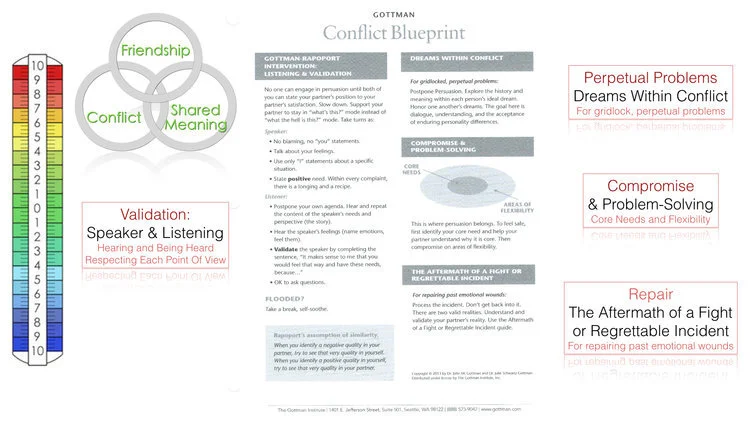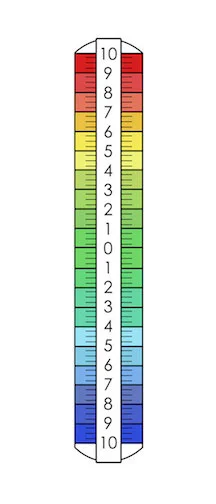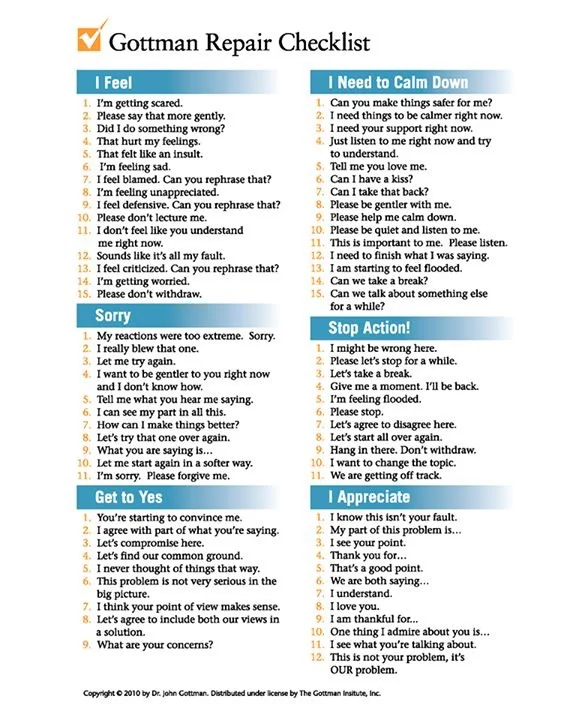Emotional Intensity Meter by Don Elium
Developmental change is different from behavioral change. People make demands on each other, assuming that what they are asking for should be easy. They don’t recognize that a lot is going on physiologically and psychologically for their partner. They are asking for growth, and in those months, for development, they stretch from their partner and can be involved in bringing about the change they are requesting.
Differentiation
“Differentiation so often gets confused with individuation. Pete and Ellyn Bader define differentiation as the active, ongoing process that usually occurs about two years after marriage or commitment. It means each partner actively defines themselves in real time when something is happening. They express their thoughts, feelings, wishes, and desires to do that.
Please remember the following text:
"They need to deal with the anxiety that arises when they disagree and want different things. These moments can lead to increased closeness or disappointment, but they are committed to being open, revealing themselves, and handling uncertainty. In couples therapy, partners can work on creating moments that encourage individuality, helping them to better tolerate and manage their own feelings and reactions. Couples who are unable to do this may misinterpret their differences as problems with themselves, their partner, or their relationship."
Remember this text:
"They do not interpret differences as challenging, growth possibilities for each partner and the relationship." — Developmental Couple Therapy by Ellyn Bader, Ph.D.
In the Gottman Method, the "ASK FOR NEXT TIME" (the last step in the Repair process) should be seen as a capacity challenge, not just a matter of willpower. Therefore, when you receive the instruction to "TRY IT A DIFFERENT WAY NEXT TIME," you should reconsider what you previously agreed on and try a different approach that satisfies more of both partners' needs and respects each other's current capacity.
Instructions:
To Repair A Disagreement, Argument or Fight
From the Research on Couples Happiness and Unhappiness by Julie and John Gottman, Ph.D.
First, some notes before you do the process, and then the process will follow:
NOTES TO CONSIDER BEFORE YOU BEGIN
1. You are processing a PAST event, not the present.
So, could you talk about how you felt in the past event, not how you feel right now?
For example,
• Do this: In that argument, I felt hurt, sad, and dismissed.
• Don’t do this: I feel angry at you now about that argument.
Reason for this Instruction: You are processing past events to feel more complete, so you can stop obsessing over them and learn from them. This allows closeness to happen. If you are feeling intense emotions about the event, indicated by being in the "yellow" or "red," you are likely flooded or soon to be. Therefore, it's best not to exercise until you are calm enough to check if your heart rate is close to or over 100 beats per minute before exercising. Both of you need to be in the "green" emotional zone so that you can stay reasonable. It's okay to feel flooded; it will help you a bit. It just means you are still hurting and need more time to calm down than to do the exercise. your pulse. You must calm down
2. BOTH points of view are correct.
"It's important to remember that a point of view is not an absolute reality; it is relative and subjective. When you're feeling overwhelmed, you might find it difficult to listen to a different point of view without getting defensive or engaging in debate. However, if you're feeling calm and open-minded, you can take an interest in understanding your partner's perspective, rather than trying to convince them of your own. The key to establishing closeness is when each person feels heard and understood in their own world, leading to openness to considering and influencing each other in a reasonable manner."
• Do this: I hear that you saw. . .
• Don’t do this: What you saw isn’t right . . .
Reason for this instruction: Repair must be about dialogue and understanding, not debate and convincing. Curiosity, interest, and compassion for self and other is needed. Otherwise, you will end the conversation feeling further distant from each other and worse than when you began. The goals are to repair and to feel better and closer.
3. Save all persuasiveness to step 6.
Reason for this instruction: Happy couples in the research waited until both people felt understood and their viewpoints considered before asking for anything. Step 6 is the Ask.
4. In step 6, remember you will “try” something different next time.
That means it may work better, or it may not. Either is helpful information for your knowledge database in yourself, your partner, and your relationship. So, keep the “trying” as experimental, where you are both looking for what works best and let that grow.
• Do this: When I have a complaint, I want to start softly and wait until I am calm to talk.
• Don’t do this: I will be soft so this doesn’t happen again.
5. Each person gets a turn on each step.
You can start with emotions first. Don’t combine steps.
Reason for this instruction: Emotions drive the intensity of the conversation and the repair. It takes the pressure off each person and helps Star focus on learning.
6. If you are flooded with intensity, in the red or rising in the yellow, SoOr, turning out, shutting down in the blue and black, stop.
Emotional Intensity Meter by Don Elium, MA MFT
When emotions are running high and reaching a "red" level, it's important to take a break until both people have cooled down andm again. The most common mistake is allowing emotions to become s okay and important to pause and come back later when one or both partners are overwhelmed. This doesn't mean to feel deeply, but rather that when emotions become overwhelming, it's time to take a break and return when feeling calmer or more emotionally e are feeling engaged. Additionally, if either partner is feeling "tuned out" or "detached" and in the "blue" zone, it's a sign of being overwhelmed, and it can inhibit reasonableness.
Reason for in’
Reason for in’
Reason for instruction: When flooded with emotions or detached from them, You cannot give in to reasonable. When flooded (red) or detached (blue), you can make matters worse but only improve them once you calm down enough to yield to reason.
7. The Language of Healing In A Repair Conversation
This is not a part of the Gottman Research or therapy itself. However, it follows in its spirit, so I included this list of 8 listening and speaking elements that heal relationships and promote closeness according to Richard Schwartz, Ph.D.'s research and his process of ifs-Internal Family Systems. It has been adapted by Don Elium, MA MFT (June 20, 2016):
The 8 C’s That Heal by Richard Schwartz, Ph.D.
Calmness - (1.) a high degree of physiological and mental serenity regardless of the circumstance(s) (2.) the ability to react to triggers in your environment in less automatic and extreme ways(3.) to be less vulnerable to adopting the typical fight-flight-freeze response when threatened. (Calmness experienced in dynamic degrees)
Curiosity - (1.) a strong desire to know or learn something new about a topic, situation, or person (2.) to have a sense of wonder about the world and how things work(3.) genuinely interested in non-judgmentally understanding something or someone. (Curiosity experienced in dynamic degrees)
Clarity - (1.) the ability to perceive situations accurately without distortion from extreme beliefs and emotions (2.) the ability to maintain one’s objectivity about a situation in which one has a vested interest (3.) the absence of preconception; and objection (opposing) (4.) the ability to maintain a “beginner’s mind” in which many possibilities exist. (Clarity is experienced in dynamic degrees)
Compassion - (1.) to be open-heartedly present and appreciative of others without feeling the urge to fix, change, or distance from them (2.) an intuitive understanding that the suffering of others affects you because of your connectedness to them (3.) to simultaneously have empathy for others and a belief that the other has a Self that once released can relieve his or her suffering. (Compassion is experienced in dynamic degrees)
Confidence - (1.) to maintain a solid personal knowledge in one’s ability to stay fully or as present as possible in a situation and handle or repair anything that happens with the belief that “no matter what, it’s all okay and will all work out the way that it can” (2.) to have the direct experience of being healed from previous traumas and learned from earlier failures to such a degree that their effect does not spill into the present (3.) to understand that mistakes are only lessons to be learned. (Confidence is experienced in dynamic degrees)
Courage - (1.) strength in the face of threat, challenge, or danger (2.) the willingness to take action toward a goal that you or others would find overwhelming(3.) the ability to recognize the damage we do to others then take action to make amends (4.) the willingness to reflect and “go inside” toward our pain and shame, carefully examine it and act on what we see. (Courage is experienced in dynamic degrees)
Creativity - (1.) the use of the imagination to produce original ideas (2.) the ability to enter the “flow state” in which expression spontaneously flows out of us and we are immersed in the pleasure of the activity (3.) the ability to create generative learning and solutions to problems. (Curiosity is experienced in dynamic degrees)
Connectedness - (1.) the state of feeling a part of a larger entity such as a partnership, family, team, community, or organization (2.) a connection to a meaningful purpose or a "higher calling" above the circumstances of daily life (3.) to be in a relationship with someone who truly knows and accepts you for who you are(4.) to be able to relax your defenses with others as you know that judgment or controlling can happen and can address openly with options and have less fear of getting hurt because you have grown degrees of confidence that you can repair damage or misunderstandings when they occur. (Connectedness is experienced in dynamic degrees)
••••••••••••••••••
THE INSTRUCTIONS:
Step-by-Step Guide To Repair A Disagreement, Argument, or Fight
I. EMOTIONS: How you felt during the past event
Could you review the list and say what you felt in the disagreement that needs repair? The more, the better to help you express to your partner how you feel. This helps relieve the intensity of the past argument.
I felt defensive.
I felt listened to.
My feelings got hurt.
I felt understood.
I felt angry.
I felt sad.
I felt happy.
I felt misunderstood
I felt criticized.
I didn’t take my partner’s complaints personally.
I felt disliked by my partner.
I felt cared for.
I was worried.
I felt afraid.
I felt safe.
I was relaxed.
I felt right and my partner wrong.
We were both partly right.
I felt out of control.
I felt in control.
I felt righteously indignant.
We were both morally justified in our views.
I felt picked on unfairly.
I felt appreciated.
I felt unappreciated.
I felt unattractive.
I felt attractive.
I felt morally outraged.
I felt taken for granted.
I didn’t feel taken for granted.
I felt like leaving.
I felt like staying and talking this through.
I was overwhelmed with emotion.
I felt calm.
I felt powerful.
I felt powerless.
I felt that I had no influence.
I felt I could be persuasive.
I felt as if my opinion didn’t even matter.
There was a lot of give and take.
I had no feelings at all.
I have no idea what I was feeling.
I felt lonely.
I felt alienated.
Other feelings
II. STORY: Share your subjective reality.
Could you sum up your point of view and your reality about the disagreement? What was your story?
III. AGREEMENT: Find something you can understand in your partner’s story.
See how your partner’s subjective point of view, their reality, makes sense, given your partner’s perspective. Tell your partner about one piece of his or her reality that makes sense to you.
IV. TRIGGERS: What triggered you during the disagreement?
What is your history, childhood, and life before this relationship became triggered during the conversation? This step is where the conflict patterns will most likely show up often. There tend to be just a handful of reactive patterns, often based on a cluster of physical, psychological, personality, and childhood concerns.
V. RESPONSIBILITY: Accept some responsibility.
I think you should admit your role in the conflict and what you did that made matters worse.
I have been very stressed and irritable lately.
I have not expressed much appreciation toward my partner lately.
I have I have been very stressed and irritable lately.
I have not expressed much appreciation toward my partner lately.
I have taken my partner for granted.
I have been susceptible lately.
I have been highly critical lately.
I have not shared very much of my inner world.
I have not been emotionally available.
I have been turning away from my partner.
I have been getting easily upset.
I have been depressed lately.
I have had a chip on my shoulder lately.
I have not been affectionate.
I have not made time for good things between us.
I could have been a better listener.
I have yet to ask for what I need.
I have been feeling like a martyr.
I have needed to be alone.
I have not wanted to take care of anybody.
(Add your own)
Overall, my contribution to this disagreement was __________.
VI. NEXT TIME: Make it better in the future
This is where persuasion is appropriate. Not trying to manipulate, but asking for the favor of trying something different. By the time you get to this step, you both will see possibilities to try differently next time. Be sure to start with what YOU will try next time. Then have your partner go. Then, what is your "ask" for your partner to try next time? Then, what is theirs for you? If the "ask" is too far of a stretch for either of you, adjust it to something you can try that is reasonable. Remember, it may not work out, so whatever happens, it is okay to learn from and try repeatedly as you learn to care about yourself and each other.
1. One thing you could try next time? (Let each respond before moving to number 2)
2. One thing you would like your partner to try differently next time?
The Aftermath of a Fight, by John and Julie Gottman, and some adaptations by Don Elium, MA, MFT, for his counseling sessions.








